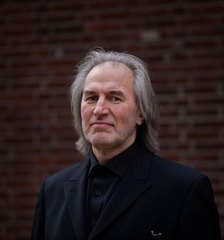|
Back
Miracles over Three Millenia New York
Dendur Temple, Sackler Wing, Metropolitan Museum of Art
06/02/2014 -
Arvo Pärt in the Temple of Dendur:
Arvo Pärt: Kanon Pokajanen
Estonian Philharmonic Chamber Choir, Tõnu Kaljuste (Director)

T. Kaljuste (© Courtesy of the Artist)
Like the whirl of time in the Egyptian Book of the Dead, last night’s concert in the Sackler Wing of the Metropolitan Museum of Art whirled over three continents, from the earliest millennia to the world of today.
At its earliest, the room was surrounded by transferred original Dendur Temple walls, yet these were not Egyptian but designed by a Roman Governor. (The truth is that the more authentically and artistically Egyptian of the older dynasties is in the rooms which surround the temple, with their endless icons, statues and mosaics.)
Go up now a thousand years, for the words to Arvo Pärt’s Kanon Pokajanen (Canon of Repentance), written in Church Slavonic by a Cretan Saint when the Byzantine Church was at its peak. Go up 1,300 more years, and Arvo Pärt had taken these words and put them in the 90 minute prayer, a prayer embracing both the Old and New Testaments.
Ancient as the originals might have been, this part of the Arvo Pärt Celebration was as contemporary as possible, since the entire Kanon Pokajanen had been written by the composer for the Estonian Philharmonic Chamber Choir, and dedicated to its director, Tõnu Kaljuste. And since these were the performers last night, any scintilla of criticism would be an act not of audacity but–in the religious frame of the evening–a venal sin.
The place for the music was appropriate. While one could see the trees of Central Park through the windows of this auditorium, Arvo Pärt’s music was absolutely hermetic. His is not the music or prayer of pantheistic or pagan nature worship. It is inward, searing to the soul, and totally hermetic. From the very first notes, resounding through the auditorium, one has the feeling of inner luminosity, of inner suffering and supplication.
And while some work of Arvo Pärt is either overplayed (like Fratres) or has a numbing monotony, this work has an unhindered luminosity. In fact the odes and prayers of Kanon Pokajanen, while frequently repeating tropes and phrases, always seems to be going forward, always reaching for an “ultimate” music.
Although I couldn’t possibly follow the English translation in the program (Church Slavonic is not taught in New York schools), the meaning of the words does not seem to bear much on the music. The “flames”, the “bitter hour of death”, the familiar “kyrie eleison”–begging for mercy–needed no literal translation.
One has the feeling here that Arvo Pärt was more interested in the sounds of the words, the elisions which always kept us on edge as to whether we were listening to modern dissonances or consonant, almost 19th Century harmonies, uttered by the females of the choir.
Yet the dissonances had their own antecedents. Many years ago I heard an old recording of Russian Orthodox Church music written prior to the 18th Century, with its European harmonies. That music sounded harsh, almost primitive. Yet the power of its sheer dissonances, discords which never had to resolve themselves, was very much like Arvo Pärt’s music.
Unlike Penderecki’s Passion, which balances between tone clusters and 14th Century harmonies, Arvo Pärt never needed to revert to another time. Kanon Pokajanen started with the full choir (less than 30 voices, but all of them resounding in this room), and even in its few solo passages–a magnificent linear melody of solo bass and tenor to the soft background of the choir–one felt a unity of the whole.
Nearly all the sections were in a single D Minor key–yet the Estonian Philharmonic Chamber Choir gave infinite variance. We had the recitatives, those beautiful solos, silences, antiphonal sounds of men and women, Arvo Pärt’s signature tintinnabulations, and one particular drone which seemed to auditorially visualize supplication. Starting on a D, the entire choir went up and down the scale, increasing in intensity and volume.
For this second of Arvo Pärt concerts, this “Canon of Repentance” one felt not only a musical but a historical coherence. Yes, this took place in an Egyptian setting, but the melodies of the Russian Orthodox Church came from the Egyptian Copts, the very first Christians whose churches are still in the northern desert. Arvo Pärt’s own background, writing for the cathedrals of both the Western and Eastern Church, is like a force of musical nature who can transcend individual chronicle to build a universal sound.
A litany of composers, from Rimsky to Rachmaninoff to the late John Tavener have attempted to imitate these two-millennia tropes of the Russian Orthodox Church, with varying success. What Arvo Pärt did last night in this glowing performance, was to take the ancient, the archaic and the ageless and to enrich it with his own sensibility. It was not music from the heart or the soul or even the choir. This “Canon of Repentance” erupted from the deepest mind of the composer to create an indefinable liaison with depths within ourselves.
Harry Rolnick
|